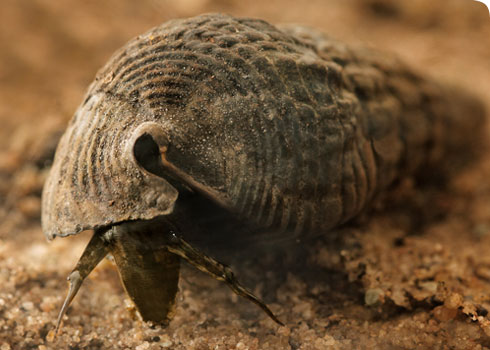Taxonomy
Appearance
Terebralia palustris (Linnaeus, 1767) is the largest snail species found in mangrove habitats, commonly reaching 120mm in length, and occasionally as much as 190mm.
The shell is thick and heavy, sculptured by 4 flat, spiral ribs on each whorl, and by longitudinal ribs that become indistinct on the final whorl.
When maximum size is reached the aperture becomes slightly flared, and there is a short, open canal at the anterior end.
The columellar pillar bears 2 spiral folds, but these are not visible from the aperture. Opposite the aperture there is a thick longitudinal boss (varix) with internal teeth, and smaller varices are scattered on the spire whorls.
The operculum is round, corneous and multispiral.
The foot is dark brown, and the broad snout and cephalic tentacles are black. The edge of the mantle forming the inhalent siphon bears a light-sensitive pit, and the gills are reduced.
The sexes are separate, and there is no penis.
In addition to its larger size, it can be distinguished from other similar potamidid snails by the flared aperture of the adult shell, which does not fully enclose the anterior canal, leaving the canal as a deep groove (rather than an encircled tube).
Juveniles can be distinguished from adult snails not only by their smaller size, but by the thin growing edge of the shell - the aperture becomes thickened and flared only when final adult size is attained.
Look-alikes
There are 2 other Terebralia species: Terebralia sulcata from the western Pacific and T. semistriata from northern Australia. These are smaller (60 and 70mm respectively), and in both the anterior canal is closed as a tube (by the edge of the aperture fusing to the columella when adult size is attained). All 3 can be found together in tropical Australia, although usually in separate microhabitats.
Another large mudwhelk is Telescopium telescopium, which reaches 130mm, but unlike Terebralia palustris this lacks longitudinal ribs or varices, and the aperture is not flared (growth is indeterminate).
The temperate Australian species Pyrazus ebeninus (Batillariidae) is superficially similar, but has knobs on the shell and an ear-shaped (paucispiral) operculum.
